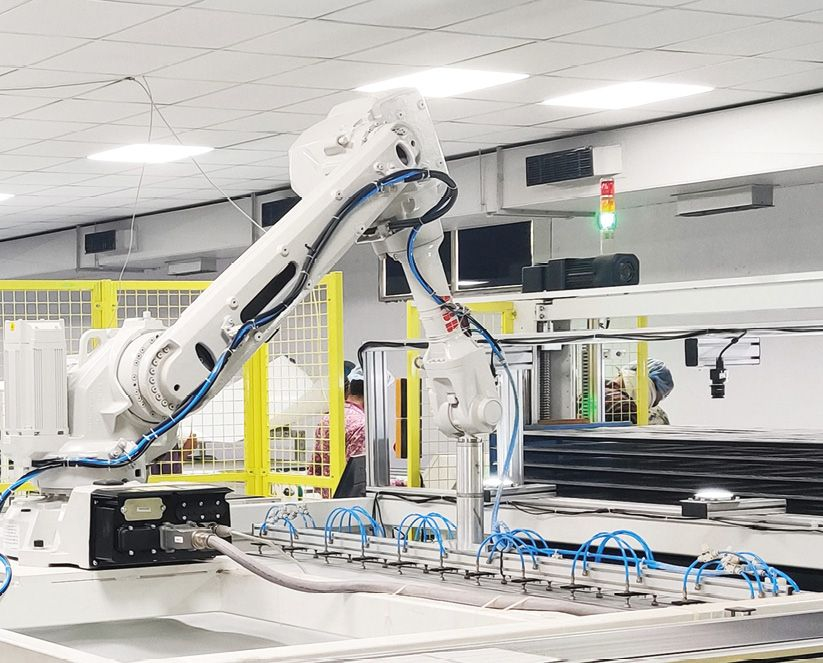In 2021, India’s annual solar manufacturing capacity stood at 14 GW. While superficially an impressive figure, much of this capacity was sub-scale and technologically obsolete, with Chinese imports meeting more than 80% of Indian demand. Even though module manufacturing capacity has now grown to 26 GW, actual production remains low, at around 8 GW annually.
There are multiple policies that have driven solar manufacturing expansion. In April 2022, the Indian Ministry of Finance levied hefty 40% and 25% border customs duties – plus a 10% surcharge – on imports of all solar modules and cells, respectively. As a result, module imports fell sharply from a monthly average of slightly more than 1.6 GW, in 2021-22, to just 175 MW in the last fiscal year.
An additional policy, the Approved List of Models and Manufacturers (ALMM) has also had an effect. Under the ALMM, all grid connected projects, including rooftop solar systems, are required to use government-certified cells and modules, made by approved manufacturers. While the scheme does not formally discriminate between suppliers on the basis of nationality, approvals have so far only been granted to Indian companies.
The scheme was meant to be applicable from March 2021 but the implementation timeline was shifted to April 2024, due to lack of sufficient domestic capacity. By July of this year, 19.2 GW of module manufacturing capacity had been approved across 78 manufacturers.
The government has allocated capital subsidies of $2.2 billion to 12 companies setting up a total manufacturing capacity of 48.3 GW under its Production Linked Incentive (PLI) scheme. Subsidy amounts will be differentiated based on parameters such as the extent of upstream integration, local value addition, capacity, and solar module efficiency. It is estimated PLI funding will amount to around 25% of investment capital costs. Notable companies to win subsidies include Reliance, Shirdi Sai, Adani, First Solar, ReNew, Tata Power, Avaada, JSW, AMP, Waaree, and Vikram Solar.
Tax and zoning
The Ministry of Finance has also reduced the corporate tax rate from 25.2% to 17.2% for manufacturing companies incorporated after September 2019, provided they go into operation before April 2024.
The government is setting up three dedicated renewables equipment manufacturing zones with capital assistance of INR 10 billion ($121 million). These zones are being selected through a competitive bidding process based on the lowest power and land costs for the manufacturing businesses. The government of the state of Madhya Pradesh has been awarded the first tranche, with a capital assistance of INR 4 billion.
Local and regional funds are also available to manufacturers. Most states offer multiple benefits including capital and operating-cost subsidies, lower general sales tax rates, cheap land, and so on. The central government is also encouraging public and private lenders to support manufacturing projects.
Policy thrust
The substantial policy thrust has resulted in a flurry of market activity. Bridge to India estimates total domestic polysilicon, cell, and module production capacities will reach 30 GW, 43 GW, and 110 GW, respectively, by 2026. That said, module supply is expected to remain constrained in the short-term until a significant chunk of new capacity comes online, by the end of 2024. Most manufacturers prefer to sell in the overseas market, particularly in the United States, where they can command up to 40% higher prices.
India is on the way to becoming the world’s second largest manufacturer of solar modules but there are still many issues and challenges to consider. There is lingering policy uncertainty as project developers are seeking another extension of ALMM and further import duty petitions are being considered by both upstream and downstream solar manufacturers. There is also the risk of World Trade Organization (WTO) disputes causing uncertainty. China has already flagged the ALMM mandate as a specific trade concern four times at the WTO.
The goal of becoming self-sufficient, as far as solar energy products are concerned, still appears elusive as upstream Indian polysilicon and wafer production capacity is expected to be insufficient to meet demand. Indian manufacturers are critically dependent on China for technology expertise, manufacturing machinery, component supplies, and even engineering skills. In the longer term, there are also concerns that the generous US Inflation Reduction Act may mean Indian modules are not cost competitive in export markets. Indian modules are expected to remain at least 25% to 30% more expensive than their Chinese counterparts.
About the author: Vinay Rustagi is the managing director of Bridge to India, a renewables-focused research company and consultancy. He advises project developers, investors, equipment suppliers, technology companies, and policymakers on a wide range of issues related to business strategy, market environment, policy frameworks, and finance.
The views and opinions expressed in this article are the author’s own, and do not necessarily reflect those held by pv magazine.
This content is protected by copyright and may not be reused. If you want to cooperate with us and would like to reuse some of our content, please contact: editors@pv-magazine.com.








By submitting this form you agree to pv magazine using your data for the purposes of publishing your comment.
Your personal data will only be disclosed or otherwise transmitted to third parties for the purposes of spam filtering or if this is necessary for technical maintenance of the website. Any other transfer to third parties will not take place unless this is justified on the basis of applicable data protection regulations or if pv magazine is legally obliged to do so.
You may revoke this consent at any time with effect for the future, in which case your personal data will be deleted immediately. Otherwise, your data will be deleted if pv magazine has processed your request or the purpose of data storage is fulfilled.
Further information on data privacy can be found in our Data Protection Policy.